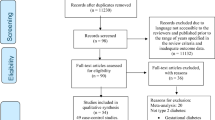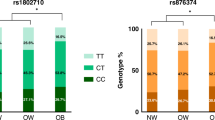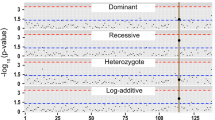Abstract
Aim:
PRD1-BF-1-RIZ1 homologous domain containing protein-16 (PRDM16) is a cell-autonomous transcriptional component that stimulates the development of brown fat cells. The aim of this study was to investigate the contribution of genetic variants of PRDM16 to obesity-related phenotype variations in Chinese.
Methods:
A total of 3204 subjects (consisting of 400 male-offspring nuclear families, 401 female-offspring nuclear families, and 729 unrelated older males) were recruited. Ten tag single nucleotide polymorphisms (SNPs) within the PRDM16 gene were genotyped using multiplex quantitative real-time PCR by Taqman assay. Body compositions were measured by dual-energy X-ray absorptiometry (DXA). The associations of the SNPs with the obesity-related phenotypes were analyzed using the quantitative transmission disequilibrium test (QTDT), GLM-ANOVA and PLINK statistical methods.
Results:
Rs2236518 was the only SNP that was associated with BMI in young (aged 20–40 years) males (P=0.011) using QTDT, and in the older men (aged 50–80 years) (P=0.003) using GLM-ANOVA. No significant associations were detected in the females. Nor was a relationship found between any haplotype and obesity-related phenotypes. When PLINK was used, no significant relationship was detected between 10 SNPs and obesity-related phenotypes in any of the studied cohorts.
Conclusion:
Rs2236518 is associated with BMI in the young males (using QTDT), and the older males (using GLM-ANOVA).However, the result is not confirmed using PLINK. The discrepancy needs to be further addressed.
Similar content being viewed by others
Log in or create a free account to read this content
Gain free access to this article, as well as selected content from this journal and more on nature.com
or
References
Perusse L, Bouchard C . Genotype-environment interaction in human obesity. Nutr Rev 1999; 57: S31–S37.
Zhang ZY, Wang MW . Obesity, a health burden of a global nature. Acta Pharmacol Sin 2012; 33: 145–7.
Kajimura S, Seale P, Spiegelman BM . Transcriptional control of brown fat development. Cell Metab 2010; 11: 257–62.
Mochizuki N, Shimizu S, Nagasawa T, Tanaka H, Taniwaki M, Yokota J, et al. A novel gene, MEL1, mapped to 1p36.3 is highly homologous to the MDS1/EVI1 gene and is transcriptionally activated in t(1;3)(p36;q21)-positive leukemia cells. Blood 2000; 96: 3209–14.
Nishikata I, Sasaki H, Iga M, Tateno Y, Imayoshi S, Asou N, et al. A novel EVI1 gene family, MEL1, lacking a PR domain (MELIS) is expressed mainly in t(1; 3)(p36; q21) – positive AML and blocks G-CSF-induced myeloid differentiation. Blood 2003; 102: 3323–32.
Seale P, Kajimura S, Yang W, Chin S, Rohas LM, Uldry M, et al. Transcriptional control of brown fat determination by PRDM16. Cell Metab 2007; 6: 38–54.
Frühbeck G, Sesma P, Burrell MA . PRDM16: the interconvertible adipo-myocyte switch. Trends Cell Biol 2009; 19: 141–6.
Tseng YH, Kokkotou E, Schulz TJ, Huang TL, Winnay JN, Taniguchi CM, et al. New role of bone morphogenetic protein 7 in brown adipogenesis and energy expenditure. Nature 2008; 454: 1000–4.
Seale P, Bjork B, Yang W, Kajimura S, Chin S, Kuang S, et al. PRDM16 controls a brown fat/skeletal muscle switch. Nature 2008; 454: 961–7.
Seale P, Conroe HM, Estall J, Kajimura S, Frontini A, Ishibashi J, et al. Prdm16 determines the thermogenic program of subcutaneous white adipose tissue in mice. J Clin Invest 2011; 121: 96–105.
Kajimura S, Seale P, Kubota K, Lunsford E, Frangioni JV, Gygi SP, et al. Initiation of myoblast to brown fat switch by a PRDM16-C/EBP-beta transcriptional complex. Nature 2009; 460: 1154–8.
Kajimura S, Seale P, Tomaru T, Erdjument-Bromage H, Cooper MP, Ruas JL, et al. Regulation of the brown and white fat gene programs through a PRDM16/CtBP transcriptional complex. Genes Dev 2008; 22: 1397–409.
Karamitri A, Shore AM, Docherty K, Speakman JR, Lomax MA . Combinatorial transcription factor regulation of the cyclic AMP-response element on the Pgc-1alpha promoter in white 3T3-L1 and brown HIB-1B preadipocytes. J Biol Chem 2009; 284: 20738–52.
Xiao WJ, He JW, Zhang H, Hu WW, Gu JM, Yue H, et al. ALOX12 polymorphisms are associated with fat mass but not peak bone mineral density in Chinese nuclear families. Int J Obes (Lond) 2011; 35: 378–86.
Stephens M, Smith NJ, Donnelly P . A new statistical method for haplotype reconstruction from population data. Am J Hum Genet 2001; 68: 978–89.
Purcell S, Neale B, Todd-Brown K, Thomas L, Ferreira MA, Bender D, Maller J, Sklar P, de Bakker PI, Daly MJ, Sham PC . PLINK: a tool set for whole-genome association and population-based linkage analyses. Am J Hum Genet 2007; 81: 559–75.
Mokdad AH, Ford ES, Bowman BA, Dietz WH, Vinicor F, Bales VS, et al. Prevalence of obesity, diabetes, and obesity-related health risk factors. JAMA 2003; 289: 76–9.
Laclaustra M, Corella D, Ordovas JM . Metabolic syndrome pathophysiology: the role of adipose tissue. Nutr Metab Cardiovasc Dis 2007; 17: 125–39.
Livshits G, Kato BS, Wilson SG, Spector TD . Linkage of gene to total lean body mass in normal women. J Clin Endocrinol Metab 2007; 92: 3171–6.
Liu YZ, Pei YF, Liu JF, Yang F, Guo Y, Zhang L, et al. Powerful bivariate genome-wide association analyses suggest the SOX6 gene influencing both obesity and osteoporosis phenotypes in males. PLoS One 2009; 4: e6827.
Jimenez-Preitner M, Berney X, Uldry M, Vitali A, Cinti S, Ledford JG, et al. Plac8 is an inducer of C/EBPβ required for brown fat differentiation, thermoregulation, and control of body weight. Cell Metab 2011; 14: 658–70.
Xi B, Shen Y, Reilly KH, Zhao X, Cheng H, Hou D, et al. Sex-dependent associations of genetic variants identified by GWAS with indices of adiposity and obesity risk in a Chinese children population. Clin Endocrinol (Oxf) 2012 Nov 3. doi: 10.1111/cen.12091. [Epub ahead of print]
Wang J, Mei H, Chen W, Jiang Y, Sun W, Li F, et al. Study of eight GWAS-identified common variants for association with obesity-related indices in Chinese children at puberty. Int J Obes (Lond) 2012; 36: 542–7.
Cao L, Choi EY, Liu X, Martin A, Wang C, Xu X, et al. White to brown fat phenotypic switch induced by genetic and environmental activation of a hypothalamic-adipocyte axis. Cell Metab 2011; 14: 324–38.
Yadav H, Quijano C, Kamaraju AK, Gavrilova O, Malek R, Chen W, et al. Protection from obesity and diabetes by blockade of TGF-β/Smad3 signaling. Cell Metab 2011; 14: 67–79.
Li D, Zhang Y, Xu L, Zhou L, Wang Y, Xue B, et al. Regulation of gene expression by FSP27 in white and brown adipose tissue. BMC Genomics 2010; 11: 446.
Acknowledgements
The study was supported by grants from the National Natural Science Foundation of China (No 81170803, 81070692, 81000360, and 30800387), Shanghai Rising-Star Program (No 11QA1404900), Shanghai Natural Science Foundation (No 11ZR1427300), and Academic Leaders in Health Sciences in Shanghai (No XBR2011014).
Author information
Authors and Affiliations
Corresponding author
PowerPoint slides
Rights and permissions
About this article
Cite this article
Yue, H., He, Jw., Ke, Yh. et al. Association of single nucleotide polymorphism Rs2236518 in PRDM16 gene with BMI in Chinese males. Acta Pharmacol Sin 34, 710–716 (2013). https://doi.org/10.1038/aps.2012.201
Received:
Accepted:
Published:
Issue date:
DOI: https://doi.org/10.1038/aps.2012.201
Keywords
This article is cited by
-
Maternal glycemia in pregnancy is longitudinally associated with blood DNAm variation at the FSD1L gene from birth to 5 years of age
Clinical Epigenetics (2023)
-
Genetic variants in the PLS3 gene are associated with osteoporotic fractures in postmenopausal Chinese women
Acta Pharmacologica Sinica (2019)
-
New insights on the origin of the basement of the Xisha Uplift, South China Sea
Science China Earth Sciences (2017)
-
Polymorphisms in Wnt signaling pathway genes are associated with peak bone mineral density, lean mass, and fat mass in Chinese male nuclear families
Osteoporosis International (2016)
-
Serum osteocalcin levels are inversely associated with plasma glucose and body mass index in healthy Chinese women
Acta Pharmacologica Sinica (2014)



